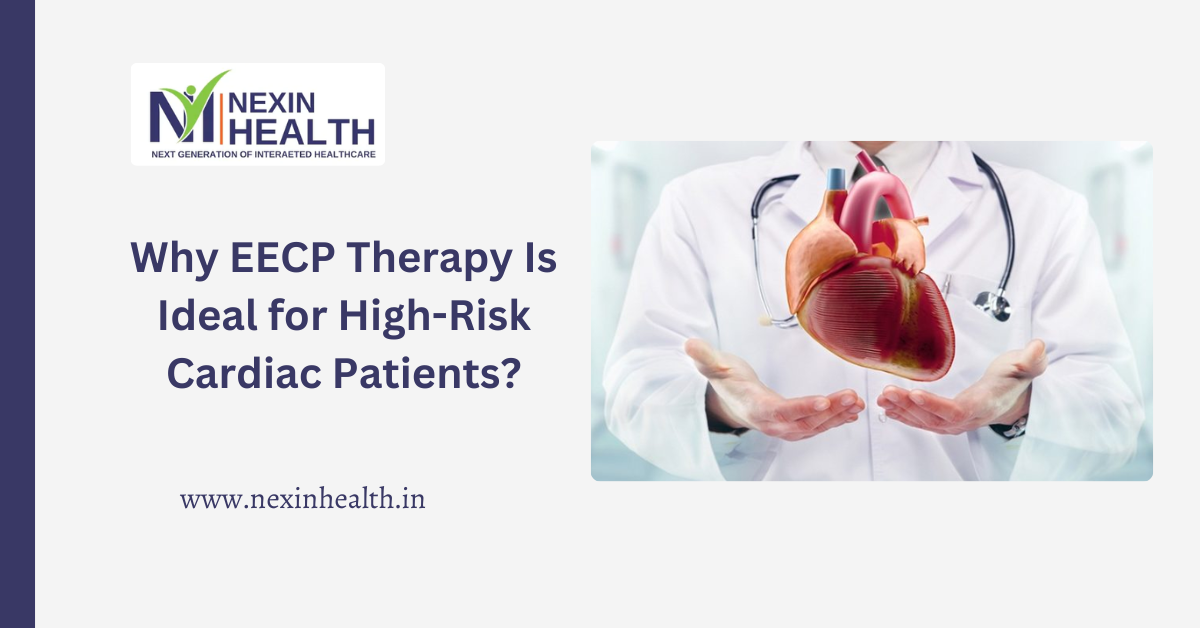Why EECP Therapy Is Ideal for High-Risk Cardiac Patients?


Cardiovascular diseases are the leading cause of mortality worldwide. For high-risk cardiac patients who are not suitable candidates for invasive procedures like angioplasty or bypass surgery, Enhanced External Counterpulsation (EECP) therapy emerges as a promising, non-invasive treatment option.
In this article, we will explore why EECP therapy is ideal for high-risk cardiac patients and how it can improve heart health without surgery.
Enhanced External Counterpulsation (EECP) therapy is a non-invasive treatment designed to improve blood circulation and reduce symptoms of angina and heart failure. During the therapy, inflatable cuffs are wrapped around the patient’s legs and inflated and deflated in sync with the heartbeat. This process boosts blood flow to the heart, promoting the formation of new blood vessels and enhancing overall cardiac function.

Non-Invasive and Safe:
Unlike angioplasty or bypass surgery, EECP therapy does not require any surgical intervention, making it safer for patients who are not fit for invasive procedures.
Improves Blood Circulation:
The therapy promotes the development of collateral blood vessels, enhancing oxygen supply to the heart muscles and reducing chest pain.
No Downtime or Recovery Period:
EECP is performed on an outpatient basis, allowing patients to resume their normal activities immediately after each session.
Clinically Proven Benefits:
Multiple studies have shown that EECP therapy improves cardiac function, reduces symptoms of angina, and enhances the quality of life in patients with coronary artery disease (CAD).
Reduces Medication Dependency:
Patients undergoing EECP therapy often experience a decrease in their need for anti-anginal medications.
EECP therapy is suitable for:
The treatment is typically carried out over 35 sessions, each lasting about an hour. Patients lie on a comfortable bed while cuffs around their legs inflate and deflate in sync with their heartbeat. There is no pain or discomfort, and patients can relax, read, or listen to music during the procedure.
While EECP therapy is generally safe, some patients may experience mild soreness or skin irritation from the cuffs. It is important to discuss your medical history with a healthcare provider before starting the treatment.
At NexIn Health, we offer advanced EECP treatment to help high-risk cardiac patients regain their health and vitality. Our team of experts ensures personalized care and the highest safety standards throughout the therapy.
1: Is EECP therapy painful?
No, EECP therapy is non-invasive and painless. Some patients may feel mild pressure from the cuffs, but it is generally comfortable.
2: How long does each EECP session last?
Each session typically lasts about one hour, and most treatment plans include 35 sessions.
3: Are there any risks or side effects of EECP?
The treatment is generally safe, but some patients may experience mild soreness or skin irritation. It is crucial to have a thorough medical assessment before starting.
4: Who should not undergo EECP therapy?
Patients with severe peripheral artery disease, blood clots, or uncontrolled hypertension should avoid EECP. A cardiologist can help determine if EECP is suitable for you.
5: How soon can I see the results of EECP therapy?
Many patients notice improvement in symptoms within a few weeks, but the full benefits are usually seen after completing the entire treatment course.
EECP therapy offers a safe and effective alternative for high-risk cardiac patients who are not suitable for invasive procedures. If you or your loved one needs advanced cardiac care, consider booking an appointment with NexIn Health for a comprehensive assessment and personalized treatment plan.